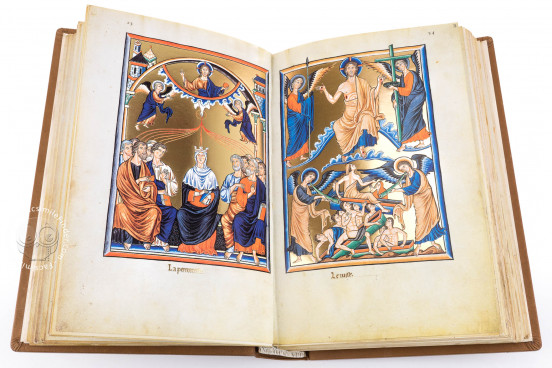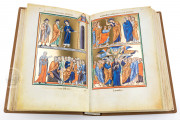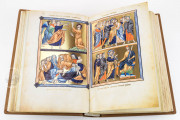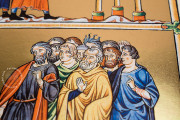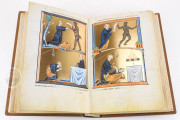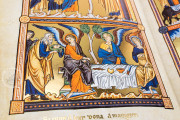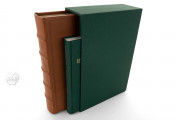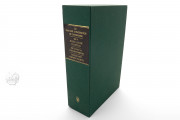The Ingeborg Psalter is a major milestone of French Gothic illumination and constitutes one of the earliest examples of a deluxe personal psalter made for a woman. The book was produced in northeastern France for Ingeborg of Denmark, probably in 1193 when she married Philip II Augustus, King of France. As one of the first books of its type made in France, the codex signals a new development in French illumination. It is especially renowned for its cycle of twenty-seven full-page miniatures that separates the calendar from the text proper.
The manuscript, designed for use in personal Christian devotions, contains a calendar, the biblical book of Psalms, a litany, and prayers in Latin. It was probably made under the aegis of Etienne de Nemours, the bishop of Noyon who arranged Ingeborg's marriage to the king.
Two Artists of Consummate Skill
The cycle of miniatures opens with four miniatures devoted to scenes from Genesis and Exodus (fols. 10v-13r). A full-page Tree of Jesse (fol. 14v) effects the transition to the extensive series of New Testament scenes (fols. 15r-33r). The focus then shifts to the Virgin Mary, starting with her death and coronation in heaven (fol. 34r) and continuing with her legendary miraculous intercession on behalf of the historical sixth-century priest Theophilus (fols. 35v-36r). The monumental figures gracefully participating in each of the narratives showcase the work of two skilled artists, one of whom was profoundly influenced by Byzantine art.
Golden Captions
The illumination is executed in brilliant color with lavish use of burnished gold. French captions written in gold briefly identify each of the scenes, the majority of which are arranged within ornamental frames decorated with geometric motifs and organized into two registers.
Made for a Repudiated and then Restored Queen
Disavowed shortly after her wedding to Philip, Ingeborg (or Isambour) spent twenty years pleading with the pope and other ecclesiastical authorities for their support in her restoration. The psalter's calendar includes entries that record the deaths of Ingeborg's parents, the king and queen of Denmark, and the victory of Philip at the Battle of the Bouvines in 1214, a year after her restoration to the throne.
Treasured by French Kings
The prayers originally employed Latin feminine endings in referring to the supplicant, as we would expect in a deluxe commission for a highly placed woman. These were changed early in the manuscript's history, probably once it came into the possession of Louis IX (1214-1270), King of France, whose former ownership is attested by a fourteenth-century inscription in the book.
The majestic codex is listed in an inventory of the goods of Charles V (1338-1380), King of France, having passed from generation to generation of French royalty. The manuscript was acquired in 1867 by Henri d'Orléans (1822-1897), Duke of Aumale, who bequeathed his collections to the Institut de France to be housed in the Chateau de Chantilly.
We have 1 facsimile edition of the manuscript "Ingeborg Psalter": Der Ingeborg-Psalter facsimile edition, published by Akademische Druck- u. Verlagsanstalt (ADEVA), 1985
Request Info / Price

